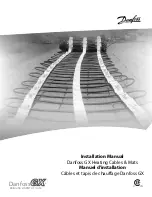
5
4
1. Operation
1.1 Space heating (SH)
The heat exchanger physically separates the district heating network from the space heating circuit. The application
minimizes the risk of contamination of district heating water as well as the risk and consequences of leakage in the space
heating circuit. The electronic regulator in the unit, together with electronic control valves and temperature sensors
regulates the temperature of the space heating.
CAUTION!
Components, pipes and radiators in, and connected to, the unit may be hot. The heat interface unit is
designed for use with space heating systems up to 90ºC. The pipes and components in the unit as well as the
pipes and radiators in the space heating installation can reach these temperatures. Contact may lead to burns.
1.2 Domestic hot water (DHW)
The HIU is equipped with single wall plate heat exchangers. The heat exchanger transfers the heat from the heat
distribution system to the domestic hot water. The electronic controller in the unit, together with electronic control valves,
/ (+ -/0- . ).*-.)ޕ*2. ).*-- "0'/ ./# / (+ -/0- *!/# #*/2/ -/*$/.. /+*$)/җ !0'/фф٠Ҙѵ
The unit has two DHW keep hot modes – Eco or Comfort mode. The default setting is Eco mode and in this mode the heat
3#)" -$.& +/0+/*/ (+ -/0- !*-р#*0-ȅ -/# './#*/2/ --2*Ȃѵȅ -р#*0-*!$)/$1$/4/# / (+ -/0- $.
allowed to drop to minimize energy consumption. The comfort mode setting is optional and can be selected at the point
of commissioning. In this mode the heat exchanger is continuously kept warm for quicker hot water delivery. To prevent
' "$*) ''!-*("-*2$)"Ѷ/# # / 3#)" -$.# / /*фф٠ 1 -4су#*0-.!*-/' ./тп($)0/ .ѵ# )/# 0)$/$.ޔ//
with the optional DHW circulation pump, the unit must be set to comfort mode.
CAUTION! Hot water
The hot water temperature is regulated to 55ºC (default value). If there is a power outage during tapping
conditions the unit will stop regulating the domestic hot water temperature. This may lead to a domestic hot
water temperature that is higher or lower than its set point. Hot water can cause burns.
1.3 Priority switching
# $.ޔ// 2$/#+-$*-$/4.2$/#$)"ѵ# )#*/2/ -$.-2)*ȂѶ/# $1 -/.''/# ޕ*2/*# /0+/# *( ./$
water. If there is a power outage during tapping conditions or during a situation where there is no request for heat from the
(connected) thermostat, the space heating valve will stay in closed position. This may lead to a decrease in temperature of
the space heating installation/circuit.
# )$)./''$)"*(+' / '4) 2 .4./ ($)) 20$'+-*+ -/4*-ޔ-.//$( $)./''/$*)$)) 3$./$)"+-*+ -/4Ѷ/# )
the heating system must conform to current building regulations Part L1a.
The appliance must be installed in accordance with, and comply to, the current: IEE Regulations, Building Regulations,
Building Standards (Scotland) (Consolidation), Building Regulations (Northern Ireland), local water by-laws, Health & Safety
Document 635 (The Electricity at Work Regulations 1989) and any other local requirements.
2.1 British and Irish standards
# - )*.+ $ޔ$)./-0/$*)$."$1 )Ѷ- ! - ) .#*0' ( /*/# - ' 1)/-$/$.#)ҝ*--$.#/)-* .*!
Practice.
BS7074:1
Code of practice for domestic and hot water supply
EN12828
Space heating for domestic premises
BS7593
Treatment of water in domestic hot water space heating systems
ECTI
National rules for electrical installations
Keep following conditions in mind during installation:
• The HIU can only be used with closed heating systems up to a temperature of 90ºC.
• The HIU must be stored and installed in a frost free area.
• The HIU must not be exposed to direct sunlight.
• Ambient temperature must be b5ºC and +40ºC.
• Humidity must be between 20% and 80%.
• Temperatures of components in the HIU and connected to the HIU can reach high temperatures. Contact may lead
to burns.
сѵс$//$)")(*$ޔ/$*).
Fitting the appliance and any controls to the appliance may only be carried out by a competent engineer. Any misuse or
0)0/#*-$. (*$ޔ/$*)./*/# ++'$) *-..*$/ *(+*) )/.).4./ (.*0'$)1'$/ /# "0-)/ )
may lead to serious injury or even death. The manufacturer accepts no liability arising from any such actions, excluding
statutory rights.
2. General Plumbing Requirements




































